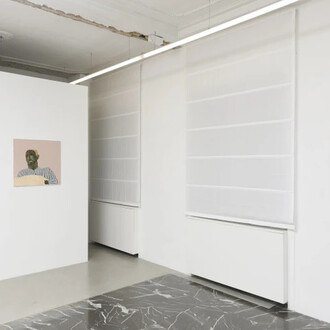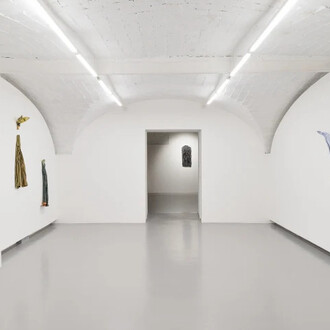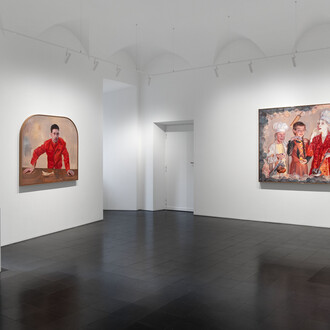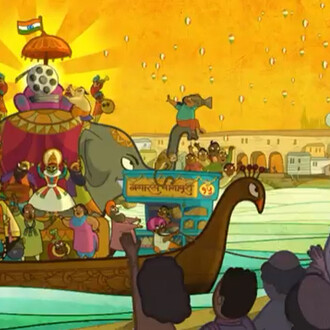Federica Schiavo Gallery is pleased to announce 02. 74. 75. 76, a group exhibition by Salvatore Arancio, Svenja Deininger, Jay Heikes, Ishmael Randall Weeks, Andrea Sala and Patrick Tuttofuoco.
The exhibition gathers artists of the same generation born between the baby-boomers and the millennials, with a life split between an analogical childhood and a digital adulthood.
The experience of this crucial transition has influenced their way of perceiving their present, which is seen through a nostalgic yet proud memory of a world that will never be the way it was. It is the generation of children who mostly played outdoor, who built their own games, before the outburst of video games, who still wrote each other’s postcards. They had to pick up the receiver and compose a home number to talk or meet with their friends, inevitably making their family aware of their private lives. But it is also the generation that has been the enthusiastic protagonist of the rapid spread of internet and the digital world.
The main interest at the centre of Salvatore Arancio’s (Catania, 1974) artistic practice, lies in the potential of images and particularly in how images and their meaning can be re-framed or re-viewed. He plays with symbols always aiming to retain a certain ambivalence in his work. Through the use of a range of media: ceramics, etching, collage, animation and video, Arancio gives the sensation of a compact and homogeneous concept, regardless of the fact that his practice is paradoxically composed of contrasting elements. Each of its facets, contains an intertwining juxtaposition of the roots and representation of images: natural and artificial, mineral and vegetable, two-dimensional and three-dimensional, scientific and mythological. Departing from their literal meaning, Arancio creates new juxtapositions that are both beautifully evocative and deeply disquieting. His work functions like an Atlas of confusion, like figures in positivistic scientific volumes devoid of any substantial image and left only with a vague ambiguous frame.
In her paintings Svenja Deininger (Vienna, 1974) concentrates on specific aspects, or segments of a space. The relationship to reality is not overt, yet is expressed. “It is important to me that the painting can be seen as a process, when an old image surfaces like a collage, and one often cannot tell which layer is on top and which on the bottom. This is why shapes of frames often appear, and white areas suggesting light sources that usually are the pure base coat. This is how spatiality develops, not as a translation of our physical reality into painting, not as colours forming a symbolic language, but as atmosphere – that’s why they aren’t really abstract paintings”.
Jay Heikes (Princeton, 1975) is capable of merging abstract painting, video, installation, performance and sculpture with a common romantic approach, and a grotesque, amused mood that characterizes his approach. His work shows the precarious nature of all allusions to the real, particularly the continuous changes and shifts of all cultural, visual, and experiential references. It captures how different materials engage with each other, especially after a chemical change. The sheer materiality of Heikes’ recent work reflects his dissatisfaction with contemporary art in the participatory, performative tradition, and a desire to return attention to painting, sculpture and installation.
Ishmael Randall Weeks (Cusco, 1976) focuses mainly on geographical, architectural and cultural spaces with a reference to time seen as the moment in which the past, the present and the future meet. Profound is his interest in the specificity of the materials of origin, considered precious instruments and whose meaning must be intertwined with his transformative states, with particular attention to archeology and museology.
Andrea Sala’s (Como, 1976) artistic research, inspired by the traditional aesthetic and the XIX Century’s avant-gardes, in particular in Architecture and Visual Arts, focuses on the essentiality of shapes and in the use of traditional techniques applied to industrial materials and vice versa. He works on new habitat and worlds by mixing images, oscillating between reality, fiction and imagination. Giving special attention to the forms of design and architecture, questioning the materials that constitute them and their formal values, the artist masters and transforms existing forms, finding their new potentialities and reframing them into new positions and contexts.
Patrick Tuttofuoco’s (Milan, 1974) practice is conceived as a dialogue between individuals and their ability to transform the environment they inhabit, by exploring notions of community and social integration in order to combine immediate sensorial allure with the power to trigger profound theoretical responses. Tuttofuoco melds Modernism and Pop; he presses figuration into abstraction, using man as the paradigm of existence, as the matrix and measuring unit of reality. From this interpretative and cognitive process, infinite versions of man and the context of his existence are produced, from which shapes able to animate the sculptures are generated.
















